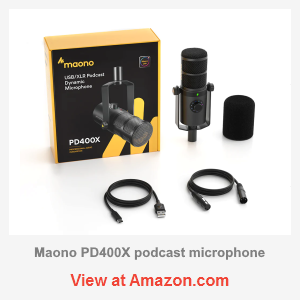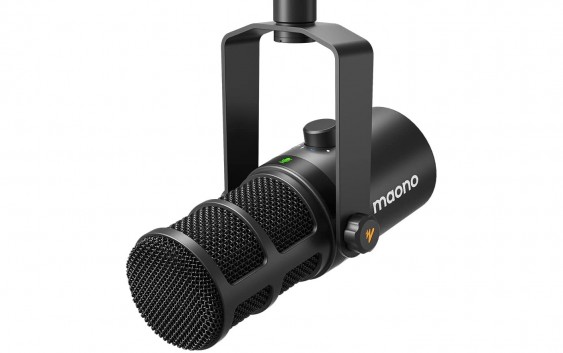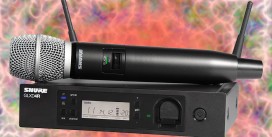Maono PD400X is a budget broadcast dynamic microphone that comes with a USB interface at no additional cost. For the most part it has a natural response, a little bit on the bright side with lots of air to it. The higher frequencies can be further boosted via EQ but even without it, PD400X sounds very crispy, especially for a dynamic mic. Good clarity and high output makes it an ideal choice for entry podcasting, meanwhile a direct USB connection and Maono app where you can access the settings help to further simplify the process. This mic however is sensitive to mechanical vibrations, so it’s best if you can avoid from touching it as well as slamming your desk and keyboard.
Sound & quality
Maono PD400X as a broadcast [or rather podcast] mic delivers a quality low end and bestows you with what I call a “broadcaster effect”. It does sound rich without being artificial or puffy – this is the type of voice you will often hear on radio or TV. Although it does have a bit of proximity effect too unlike for instance a more advanced Electro Voice RE20, the frequency at which it occurs is well beyond the normal vocal range so it does not color the vocals. It is the same principle as with LDC (condenser mics) that makes them so popular. In terms of comparison, it’s probably not the richest – Rode Procaster will easily sound deeper.
Maono PD400X doesn’t have any hype, it is as natural as it gets and unlike the former it doesn’t need any additional EQ, making it easier to stream or podcast from get go. Maono also offers basic EQ presets for low cut and high boost. Low cut helps reducing proximity, popping, mechanical noise and HVAC. The high boost’s main purpose is to give it even more air in order to compensate for when you are using a foam that comes with the mic. Speaking of which, the foam is somewhat bulky, it makes the mic look way bigger (in comparison to SM7B) so I wouldn’t use it by default, but it certainly does what it’s supposed to do. Still highly optional; I can easily breathe into the mic with no foam on, without any consequences, whereas my condensers would clip.
 What I like about PD400X is its high sensitivity and relatively high gain, which usually isn’t the case with dynamic mics. You don’t have to be on top of it – at 5 inch distance you would still have a decent gain for your streams. The crispness of the high end paired with its high sensitivity makes it comparable to condensers but without the inherent disadvantages. I like that extra bit of brightness there, it beats the industry standard SM7B on transients and offers more clarity too, which is amazing for its price. However, while SM7B may lack a bit of punch (and by the way also require a lot of external gain), it still remains my preferred though for different reasons.
What I like about PD400X is its high sensitivity and relatively high gain, which usually isn’t the case with dynamic mics. You don’t have to be on top of it – at 5 inch distance you would still have a decent gain for your streams. The crispness of the high end paired with its high sensitivity makes it comparable to condensers but without the inherent disadvantages. I like that extra bit of brightness there, it beats the industry standard SM7B on transients and offers more clarity too, which is amazing for its price. However, while SM7B may lack a bit of punch (and by the way also require a lot of external gain), it still remains my preferred though for different reasons.
Application
Maono PD400X is quite susceptible to mechanical noise, so in order to get the best out of your purchase you must ensure your application does not involve banging it directly as well as the things around you. If you are frequently moving around or having lots of desktop activity, such as typing, the audience will hear those thuds, bumps and keyboard strokes. It can get annoying for some – for others absolutely not crucial. If you are streaming it will largely depend on your audience. On the other hand, for podcasts where you can sit quietly and just talk, this mic can do wonders. Voiceovers is another good application that comes to mind. Simply using a boom arm will provide some noise mitigation, but there is no way to eliminate it completely.
USB interface, Maono app and features
For those who wonder about the built in USB interface, it’s actually quite good. The USB bus and RF noises are minimal. It has slightly more white noise, somewhere around 3 dB higher than a top quality dedicated USB interface that I used for testing, but that’s really nothing. This is still much better than most of the USB mics out there. Also you get an access to EQ presets, such as low cut and high boost. You can control the gain, headset volume and “in the mix” while using the direct monitor. This mic has a handy touch mute feature too that changes LED to red while on mute. In Maono app, aside from the above you can also configure a limiter and compressor. It’s useful when you occasionally scream, sneeze or burst in laughter.
Conclusion
Maono PD400X is an excellent value for money broadcast microphone. It does everything you would expect from an XLR mic, except there is also a USB interface with all its corresponding features. Dynamic cardioid capsule in this type of mic provides good side rejection with little proximity up close, it is also more forgiving than condensers. The digital interface provides high gain and EQ presets, and that’s all you need to start streaming. It brings the best of two worlds, getting kudos for innovation …and did I mention the price? Overall, the mic is perfectly suited for podcasting. It can handle any voice with clarity and the audio quality is ideal for the purpose. However it is susceptible to mechanical noise. Those who like to rumble are probably better off with mics that can use shock mounts.
- Reviewed at $149.99
Pros
|
Cons
|












